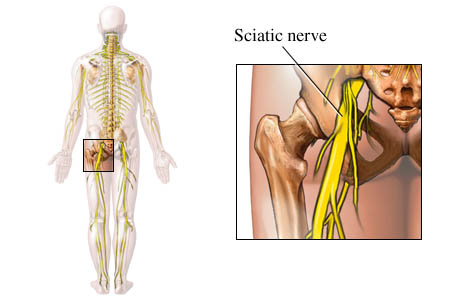Sciatica
Current as of: March 21, 2017
Author: Healthwise Staff
Medical Review: William H. Blahd, Jr., MD, FACEP - Emergency Medicine & Kenneth J. Koval, MD - Orthopedic Surgery, Orthopedic Trauma

Illustration copyright 2000 by Nucleus Communications, Inc. All rights reserved. http://www.nucleusinc.com
The sciatic nerve is the largest nerve in the body, formed by nerve roots coming out of the spinal cord in the lower back. The nerve goes down through the buttock, then its branches extend down the back of the leg to the ankle and foot.
A herniated disc may compress one or more of the nerve roots that form the sciatic nerve. Pressure on one of these nerve roots will often produce distinctive symptoms of sciatica, such as pain, numbness, weakness, and tingling in the affected leg.
Although a herniated disc is the most common cause of sciatica, sciatica can also be a symptom of other problems, such as narrowing of the spinal canal (spinal stenosis), nerve root compression resulting from injury, and certain rare tumors.
Current as of: March 21, 2017
Author: Healthwise Staff
Medical Review: William H. Blahd, Jr., MD, FACEP - Emergency Medicine & Kenneth J. Koval, MD - Orthopedic Surgery, Orthopedic Trauma
This information does not replace the advice of a doctor. Healthwise, Incorporated, disclaims any warranty or liability for your use of this information. Your use of this information means that you agree to the Terms of Use. Learn how we develop our content.
To learn more about Healthwise, visit Healthwise.org.
© 1995-2018 Healthwise, Incorporated. Healthwise, Healthwise for every health decision, and the Healthwise logo are trademarks of Healthwise, Incorporated.